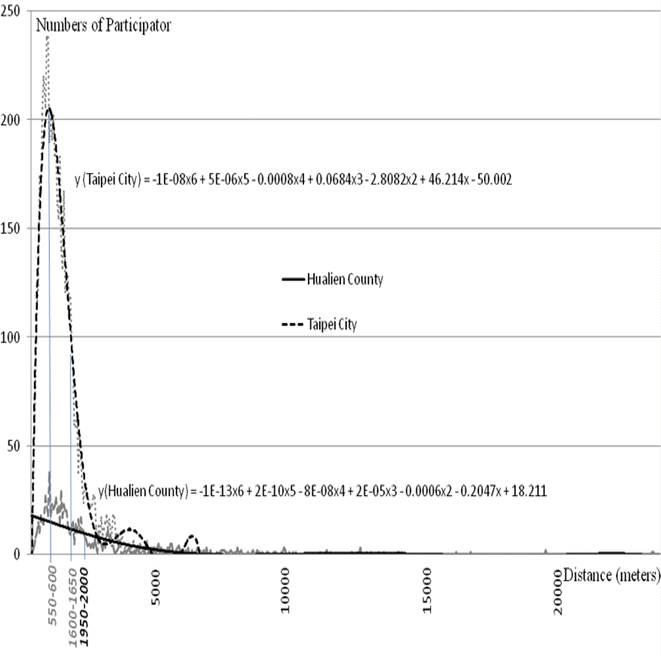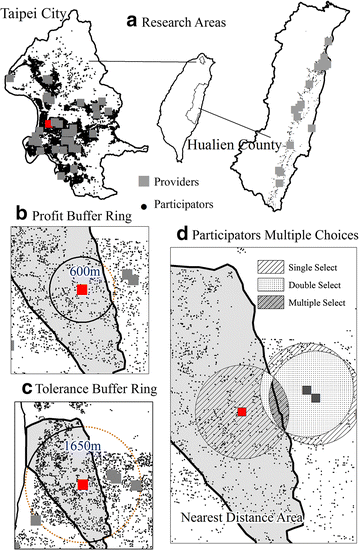New indices for home nursing care resource disparities in rural and urban areas, based on geocoding and geographic distance barriers: a cross-sectional study
- PMID: 26449322
- PMCID: PMC4598966
- DOI: 10.1186/s12942-015-0021-9
New indices for home nursing care resource disparities in rural and urban areas, based on geocoding and geographic distance barriers: a cross-sectional study
Abstract
Background: Aging in place is the crucial object of long-term care policy worldwide. Approximately 15.6-19.4% of people aged 15 or above live with a disability, and 15.3% of them have moderate or severe disabilities. The allocation of home nursing care services is therefore an important issue. Service providers in Taiwan vary substantially across regions, and between rural and urban areas. There are no appropriate indices for describing the capacity of providers that it is due to the distances from care recipients. This study therefore aimed to describe and compare distance barriers for home nursing care providers using indices of the "profit willing distance" and the "tolerance limited distance".
Methods: This cross-sectional study was conducted during 2012 and 2013 using geocoding and a geographic information system to identify the distance from the providers' locations to participants' homes in urban (Taipei City) and rural (Hualien County) areas in Taiwan. Data were collected in-person by professionals in Taiwanese hospitals using the World Health Organization Disability Assessment Schedule 2.0. The indices were calculated using regression curves, and the first inflection points were determined as the points on the curves where the first and second derivatives equaled 0.
Results: There were 5627 participants from urban areas and 956 from rural areas. In urban areas, the profit willing distance was 550-600 m, and we were unable to identify them in rural areas. This demonstrates that providers may need to supply services even when there is little profit. The tolerance limited distance were 1600-1650 m in urban areas and 1950-2000 m in rural areas. In rural areas, 33.3% of those living inside the tolerance limited distance and there was no provider within this distance, but this figure fell to just 13.9% in urban areas. There were strong disparities between urban and rural areas in home nursing care resource allocation.
Conclusions: Our new "profit willing distance" and the "tolerance limited distance" are considered to be clearer and more equitable than other evaluation indices. They have practical application in considering resource distribution issues around the world, and in particular the rural-urban disparities for public resource.
Figures



Similar articles
-
Justice in Dementia Care Resource Allocation: How Should We Plan for Dementia Services?Int J Environ Res Public Health. 2019 May 17;16(10):1754. doi: 10.3390/ijerph16101754. Int J Environ Res Public Health. 2019. PMID: 31108928 Free PMC article.
-
Do rural and remote areas really have limited accessibility to health care? Geographic analysis of dialysis patients in Hiroshima, Japan.Rural Remote Health. 2013;13(3):2507. Epub 2013 Aug 27. Rural Remote Health. 2013. PMID: 23984839
-
Informing equitable access to care: a cross-sectional study of travel burden to primary and rheumatology care for people with rheumatoid arthritis.Int J Equity Health. 2025 Mar 27;24(1):84. doi: 10.1186/s12939-025-02439-w. Int J Equity Health. 2025. PMID: 40148943 Free PMC article.
-
Exposing some important barriers to health care access in the rural USA.Public Health. 2015 Jun;129(6):611-20. doi: 10.1016/j.puhe.2015.04.001. Epub 2015 May 27. Public Health. 2015. PMID: 26025176 Review.
-
Rural and urban disparities in access and quality of healthcare in the Japanese healthcare system: a scoping review.BMC Health Serv Res. 2025 May 9;25(1):667. doi: 10.1186/s12913-025-12848-w. BMC Health Serv Res. 2025. PMID: 40346516 Free PMC article.
Cited by
-
Justice in Dementia Care Resource Allocation: How Should We Plan for Dementia Services?Int J Environ Res Public Health. 2019 May 17;16(10):1754. doi: 10.3390/ijerph16101754. Int J Environ Res Public Health. 2019. PMID: 31108928 Free PMC article.
-
Trends in Coprescription Among Taiwanese Children from 2002 to 2012.J Multidiscip Healthc. 2023 Dec 29;16:4307-4320. doi: 10.2147/JMDH.S416892. eCollection 2023. J Multidiscip Healthc. 2023. PMID: 38169977 Free PMC article.
-
Estimation method for distance cost to access medical services: Policy and patient privacy implications in Taiwan.Front Public Health. 2022 Dec 22;10:1065742. doi: 10.3389/fpubh.2022.1065742. eCollection 2022. Front Public Health. 2022. PMID: 36620287 Free PMC article.
References
-
- World Health Organization. World Report on Disability. Geneva; 2011.
-
- Ministry of Health and Welfare. Statistics of Population with Disabilities. Taiwan; 2014.
-
- Chan HS. Ten years long-term care program. Taipei; 2009.
-
- Mynatt ED, Essa I, Rogers W. Increasing the opportunities for aging in place. In: Proceedings on the 2000 conference on Universal Usability. Arlington, Virginia, USA; 2000.
Publication types
MeSH terms
LinkOut - more resources
Full Text Sources
Other Literature Sources
Medical

